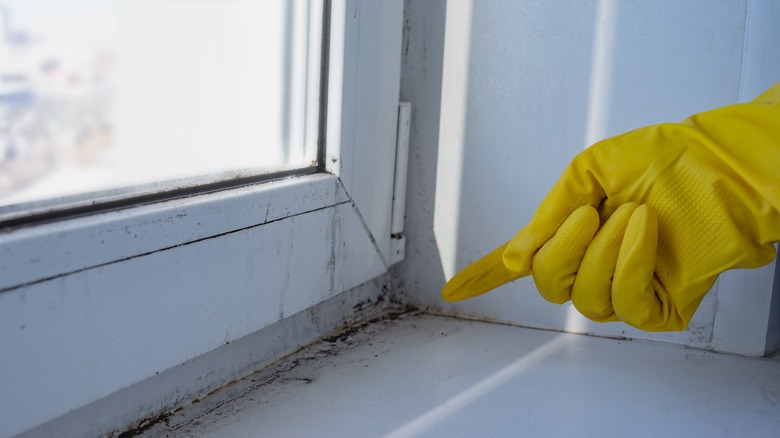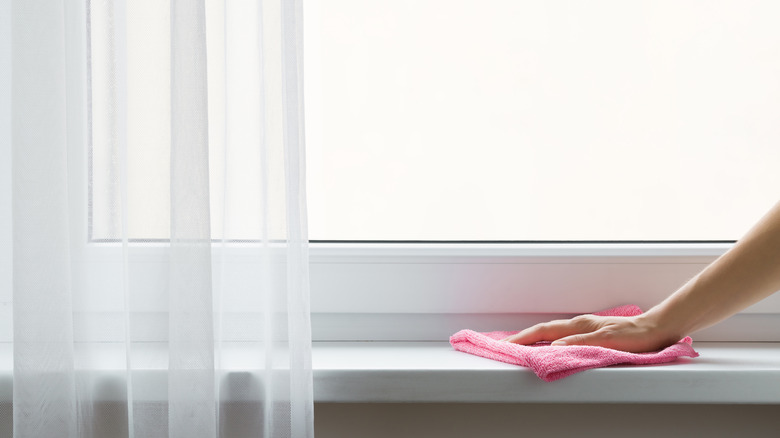Vinegar And This Laundry Room Staple Are The Solution To Mildew-Free Windowsills
You may have noticed that your windowsills are easily overlooked but especially prone to getting dirty and sometimes even developing mildew. Since windowsills are a flat, horizontal surface, it's easy for dust, pollen, and other debris to land here and go unnoticed. Once you open your windows, air currents can bring a number of contaminants sailing in too, including mildew spores. When the windows are shut, condensation can develop on window panes and simultaneously the flat windowsills below, creating moisture, an ideal environment for mildew and mold to breed. If your windowsills are obscured with curtains or furniture, it can be easy for these colonies to go unseen until it becomes a more immediate issue. Nevertheless, one simple way to tackle these mildew infestations is by using a combination of two microbial fighting powerhouses: vinegar and borax.
Combining vinegar and borax is a great way to clean mold and mildew from your window sills. It is particularly effective because vinegar is acidic and boasts antimicrobial properties, making it ideal for killing mildew spores. At the same time, it can dissolve and loosen dirt and grime, making them easier to wipe up. Borax is also a powerful cleaner and disinfectant that will continue to fight mildew colonies even after it's cleaned up, as it leaves behind an alkaline residue. Using borax and vinegar together yields an especially potent cleaning solution that kills the mildew on your windowsills and ensures that it won't return any time soon.
Cleaning with vinegar and borax
Removing window sill mold and mildew is an easy, environmentally-friendly way to help restore your home to a clean and fresh-smelling space. In a small bowl, mix equal parts of white vinegar and borax using a clean toothbrush or spoon. Combine until the two form a paste. Using a clean rag or towel, gently wipe the surface of the windowsill to remove any easy-to-clean debris like dust or pollen on the surface. Try your best to wipe so you don't spread any mildew spores to nearby surfaces. Alternatively, you could also use a vacuum with a brush attachment. Just be sure to clean and disinfect the brush again before using it on other surfaces so you don't spread the mildew around your home.
Next, use the toothbrush or another clean scrub brush to gently scrub the borax and vinegar paste onto the affected surface. Again, gently agitate the mildew stains with the brushes but don't scrub so vigorously that they spread. As you scrub, notice that the surface will whiten due to the borax. Once you have effectively removed the stains with the scrub brush, use a clean, damp towel or rag to wipe away any debris and the remnants of the paste. If necessary, repeat the process for difficult stains. When finished, use a clean, dry towel or rag to dry the surface completely. Mildew loves moisture, so don't give it a reason to return.
Cautions for using this method
Combining the versatile cleaning tools of vinegar and borax is a great way to tackle mildew on your windowsills as well as other difficult stains around your home. Before trying this method, though, it's a good idea to be aware of a few key precautions to protect yourself, your family, and your home. Both borax and vinegar can irritate the skin if they are mishandled. While using these products to clean, it's a good idea to wear protective gloves so your hands are not irritated by their cleaning properties. Moreover, inhaling borax or mildew can harm your health, so it's a good idea to pop that window open before you get started to increase the ventilation in your space.
Another important caution to consider is that vinegar and borax can discolor or damage certain materials. They are both generally safe for a variety of surfaces, but you should look into what material your windowsills are made of before trying this method to be sure they are compatible with these cleaners. Borax can bleach colors, so if you have dark paint color, for example, on your windowsill, it may be best to try a more gentle cleaner that won't bleach the paint. Moreover, the borax and vinegar can be abrasive, which may not be ideal for some sensitive materials or woods. At the very least, try the paste on an inconspicuous area before applying it to the entire surface.

